Stacey Roper (aka “Stace the Ace”) is a legendary pin-striper from Aotearoa (New Zealand), best known for her highly detailed work and official Rat Fink artist status. And yet, I had first heard about Stace because of the website, Frontside Betty which was hosted by a fellow Canadian, Denise Williams in the late 1990s / early 2000s. Stace was an international contributor to the site and posted several journal entries called “The Master Plan” (2002), posting her history, roadtrip stories, photos and drawings. But it was even better getting in touch with Stace and receiving a response to some questions on June 4, 2024.
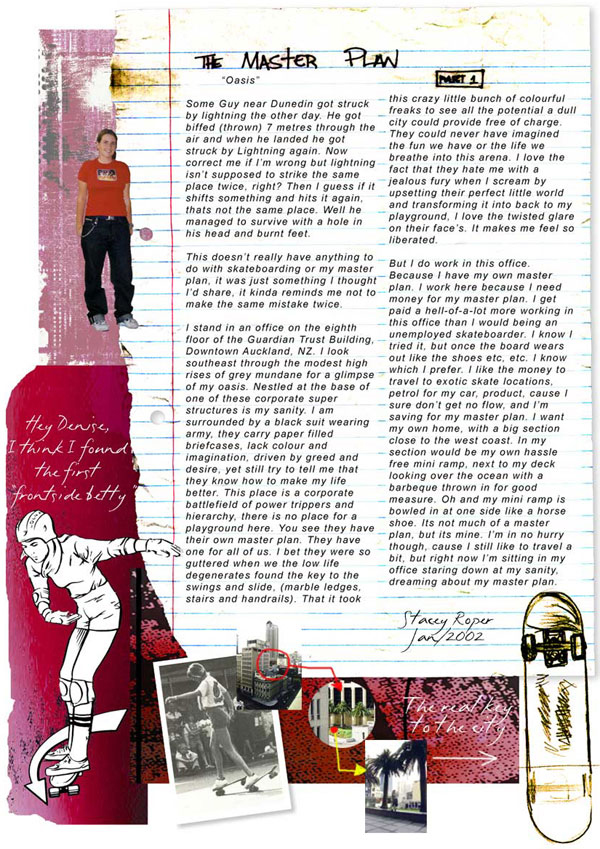
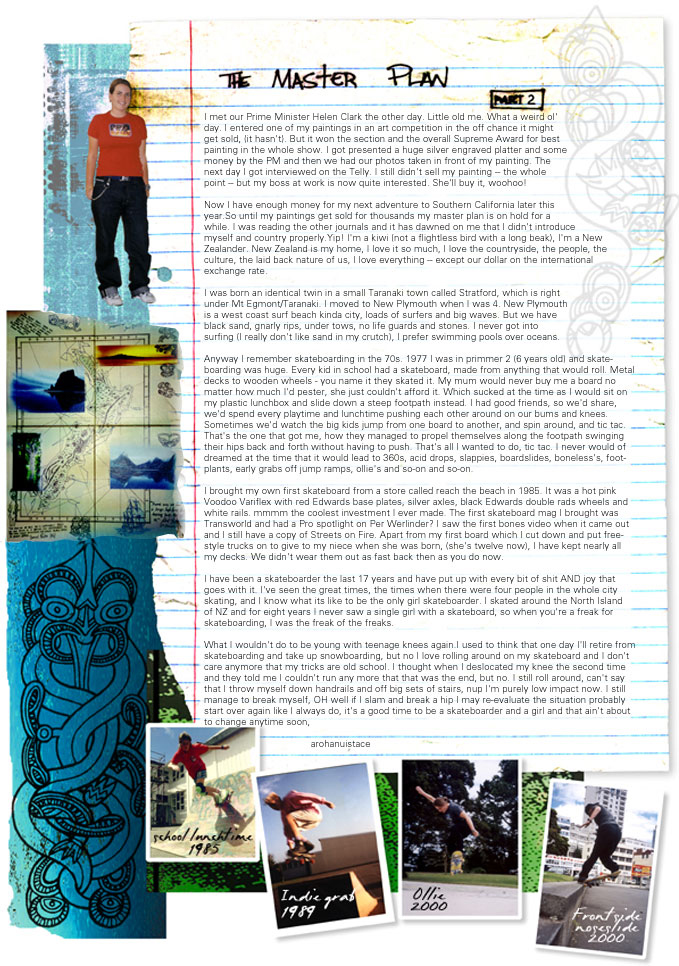
Stace was born in a small town called Stratford before her family moved to a suburb called Spotswood in New Plymouth, known as a surfing destination. Instead of surfing, skateboarding became Stacey’s passion even through a period of being one of the lone ripping female skaters in NZ when her sisters followed other pursuits.
Stacey shared, “I don’t remember the first time I saw a skateboard, I was under 5 years old and we were at my Great Aunties place and my second cousins who were much older than us all had skateboards and were riding them in the driveway. There’s a photo of us all together somewhere, us little kids are holding them in the picture. Mum said we played on them all afternoon.”
In 1977, when Stace was 6, she remembered that skateboarding had become massively popular at her school, and even the tennis court nets weren’t installed, to allow for the skaters to practise. Everyone was skating, except Stacey because her mum refused to buy one. “We did have a few really steep footpaths, so I’d sit on my school lunchbox and slide down the footpath on it. (Mum used to ask me how I got holes in my lunchbox, hahaha).”
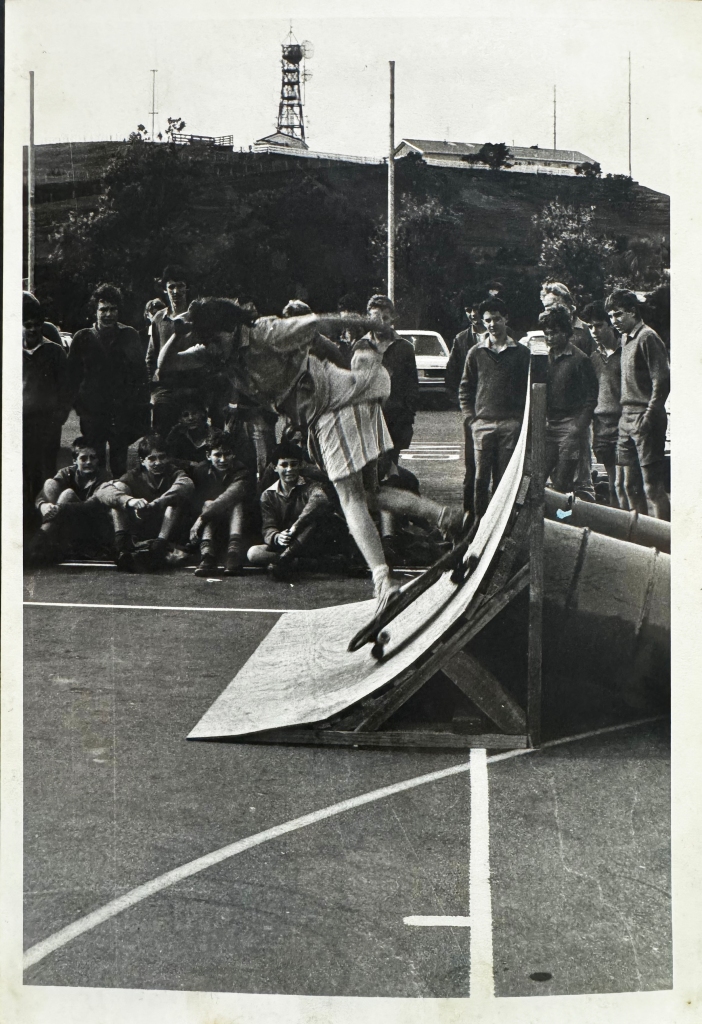
Stacey’s best friend had a skateboard and as they lived near a surf beach they would often see surfer / skaters. “I saw a guy tic-tacking with a surfboard under his arm one day and I was absolutely mesmerized at him propelling himself along the footpath just swinging his hips side to side. I had to know how he did that, still mum would not buy me a skateboard. (It wasn’t something young ladies did! Gah).” Meanwhile, around 1979-80, her brother four years younger didn’t have to wait a day. While Stace was jealous, at least she benefited from the purchase, and essentially took it over. They even nailed a chunk of wood to the tail of the yellow penny board to enable 360 spins.
By the mid-1980s, Stace noticed that the guys playing rugby at lunchtime would often leave their schoolbags and skateboards with her crew of girl friends, so she utilized the opportunity. Stace discovered she could still tictac and acid drop. “By 1986 I had sold my bicycle and bought my first skateboard (My mum still said it was just a phase). 1 Hot Pink Voodoo Variflex board, Edwards Trucks, and Edwards Double Rad Wheels. It had rails and a skid pad! I probably skated for a few years before both my sisters (cause I hung out with a lot of boys), decided to get in on it too.”
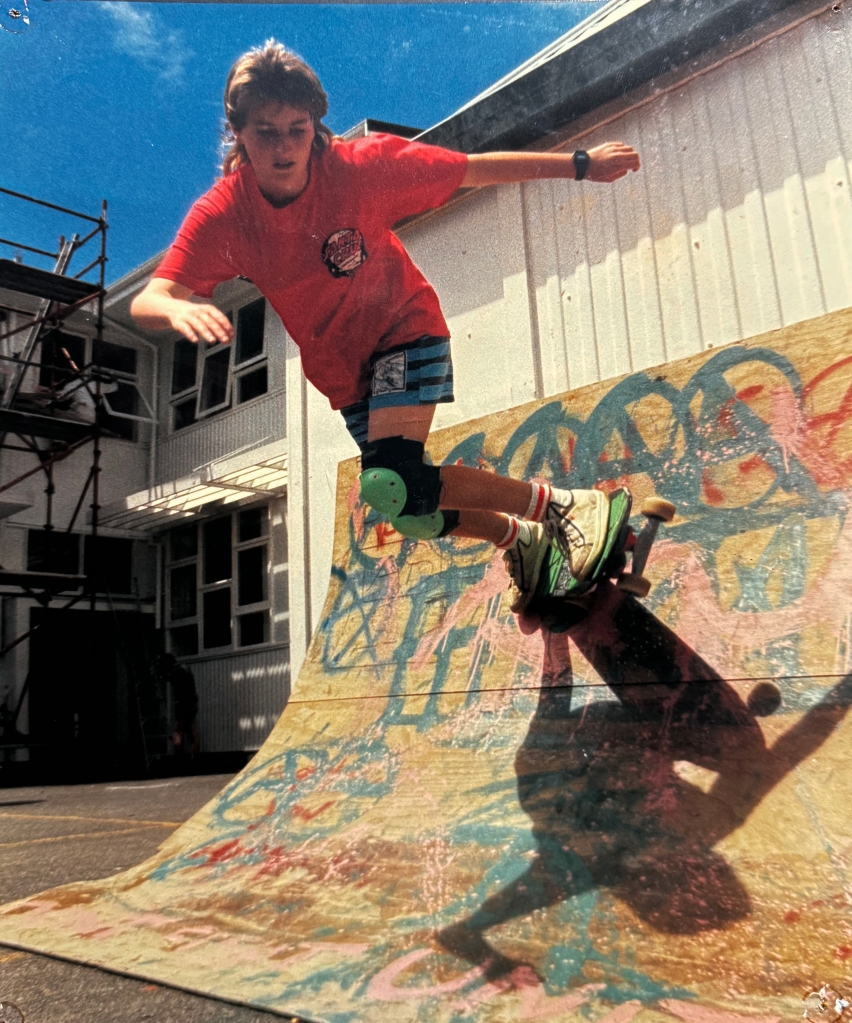
Stacey’s identical twin sister Jax, and her oldest sister by two years, Lisa decided to join in on the fun. “Both of them wrote to people, Jax wrote to Gator (we met him at a skate demo in NZ, he replied and its creepy as f*ck, because it was after the murder but before he was caught), and Lisa wrote to Sue Hazel in England (we read about her in R.A.D. Magazine, she told us about Women’s Skateboarding Network and Equal Time zine). I wrote to Lynn Kramer and JoAnn Gillespie, by the time that was happening, Lisa and Jax had pretty much moved on.”
In terms of the vibe in NZ towards female skaters, Stace wrote, “In the 1970s there was no difference if you were a guy or a girl that skated – unless you were my mum. In the 80s, girls didn’t really want to skate. I was really lucky, my guy friends were really supportive, especially my friend “Jinx”. He was the guy that was good at everything, he’d figure out tricks first, then break them down bit by bit and show me how to do them. He was the first person I saw ollie up the curb. He also wore out everyone’s VHS tapes pausing them and rewinding so much!”
The supportive attitudes were likely because, as neighbourhood kids they were hanging outdoors, doing fun things together before skateboarding arrived. “We rode bikes and built huts and explored our hoods. When the big boards came out, they were expensive, so we all tried to make our own, we’d get thick plywood that wouldn’t bend and cut them to shapes, we’d get the mail order forms out of the surf mags and copy the graphics with poster paint. I ended painting a few for my friends (all guys), they were shit skateboards but were awesome skim-boards in the rainy puddles on the sports fields. I had a great relationship with my friends in that era. (Also destined to do art and graphic design lol).”
Stace noticed a shift in attitude towards skaters in the 1980s, essentially “you were a punk rock scumbag vandal. So the general public didn’t like you from the start. They’d set dogs on you, call the cops on you, drive onto the footpath to try and run you over, the 80s metalheads would push you off your board when you skated past, I’ve been chased down the street by a dude with a baseball bat. The police dogs have been the scariest.”
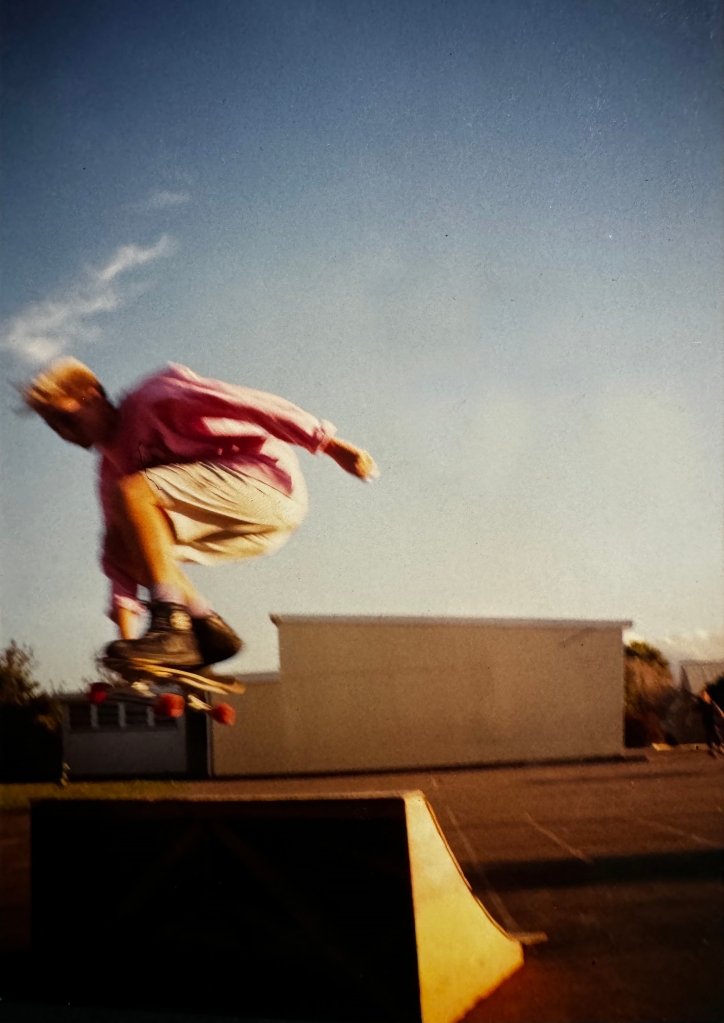
And then among skateboarders, the 1980s scene became less inclusive.
“As I got better and better at skateboarding, guys would get a little defensive (not my friends), guys from other schools and other parts of the city… I had my name written all over skatepark saying I had a penis and my brother had a vagina. I was the man in the family. I was told girls can’t skate everywhere I went. They didn’t want us at the parks. I got kicked out of a flat, because I was a skateboarder hanging out with boys, I must be a slut and doing loads of drugs. My parents hated my baggy clothes, I was a no hoper.”
“At Skateboard Nationals, I’ve had intense guys scream in my face on the course. Little kids used to be the worse hahaha, they’d say such dumb shit. Also hanging out with guys all the time and they’d forget you were there sometimes and just say the most vile & crude things about women. I never knew whether to say something and get an ear-full or say nothing and just continue to be put off by men! You needed a thick skin back in those days.”
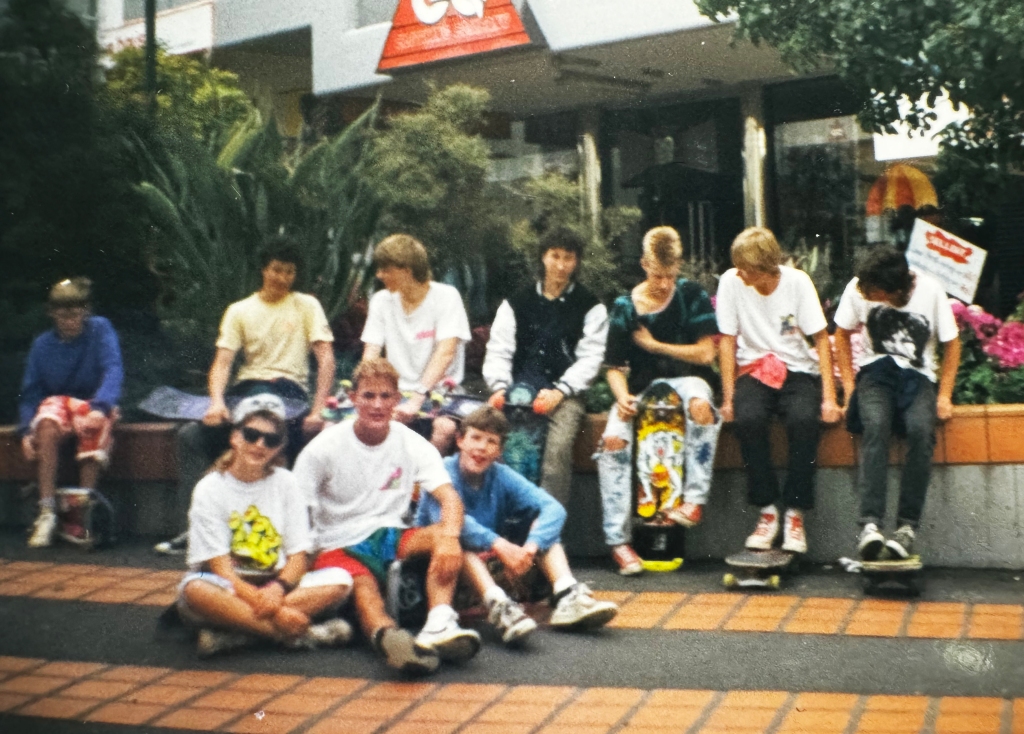
Photo: Stace is sitting left-front and Jinx is second from the right with the New Plymouth crew 1987
An incident in 1989 among fellow female skaters was especially disappointing!
“They had a National Skateboard Competition in Paraparaumu, which is near the main city of Wellington, a bunch of girls with skateboards, maybe like 12 to 17 girls rocked up, so I was there with my twin Jax & Jinx – we had no money and had bused down with a big old tent and stayed in a camp ground roughing it, nowhere near the park. Anyway I was just so excited to enter nationals…
When all those girls showed up the organisers were stoked & wanted to add a women’s section. I was beside myself with excitement. A chance to skate with other girl skaters!! Well NONE of them wanted to enter because they didn’t want to get beaten by me. I had a chance to skate with other girls, I get that our skill levels were different, but I will never forget how f*cken shit I felt being good at something and denied an opportunity to ever win a thing. I was so guttered! I never knew who they were and I never saw any of them again. I always told myself I’d never do that to any chick as long as I could roll. New Zealand has Tall Poppy syndrome and this was it at its worst!”
Stace persevered even during the quiet years, knowing that the popularity of skateboarding could ebb and flow.
“It was always fun and Jinx always pushed me to be better, his favourite thing to tell me was ‘If you land this, just imagine, you’re probably the only girl in the world that can do it!’ Hahaha, it was a great motivator. Also there were skate spots everywhere and just us skating them. I liked the empty parks too. I mean they were pretty shit parks, but there was never any pressure to be good in those days, it was just fun, I like what skateboarding sounds like, the board sliding along the ledge and the wheels screeching, the feeling is so rad!”
Stace reported that there was a period of 8 years when she didn’t see another girl skateboarding, “I’d enter comps as the only girl from 1986 to 1996.” Fortunately, she had access to the Equal Time zines, Powell-Peralta videos, Thrasher mag (August 1989) with Cara-beth Burnside on the cover. Stace even had the magazine with Saecha Clarke boardsliding a handrail (March 1991… Thrasher and/or TransWorld). So, Stace knew there ruling girls out there in the world skateboarding, just not close at hand.
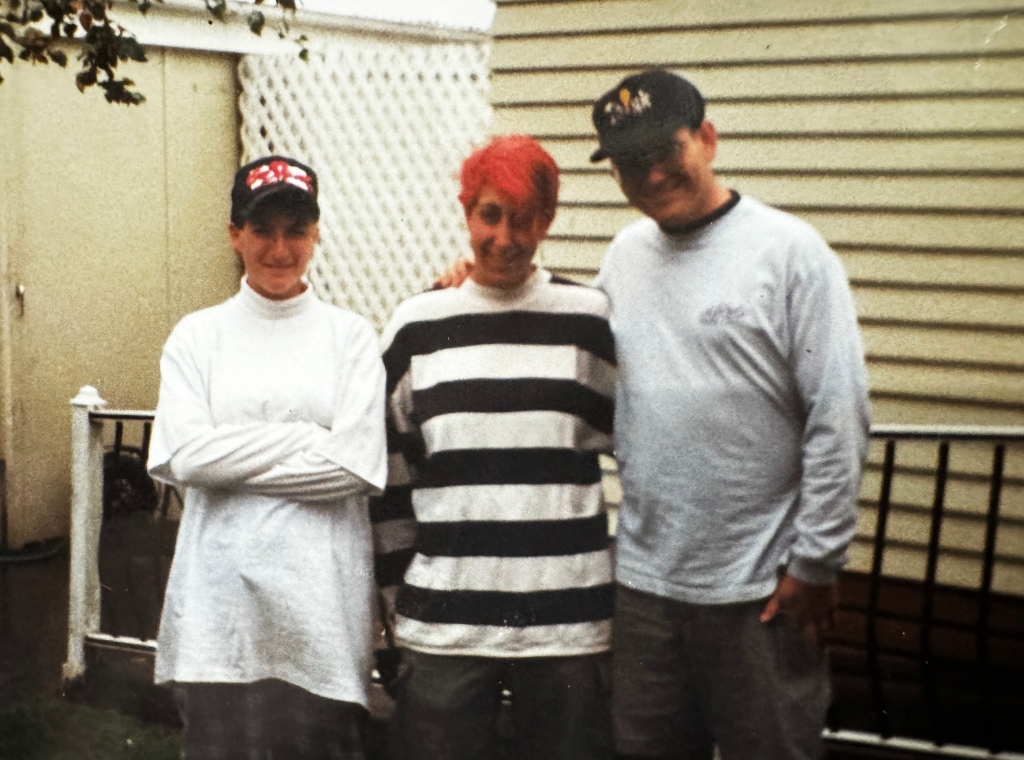
And then, Lynn Kramer, Equal Time editor, came to NZ and stayed with Stace for a few days and they went skateboarding together! “I’m so thankful that she made that happen, that was one of the greatest things I experienced, skating with another girl skater that wasn’t my sister hahaha. We’ve stayed in touch ever since. I have seen Lynn in the flesh since her visit – I’d made it to the States for a few All Girl Skate Jams and went to the ASR Trade shows a few times. I caught up with Lynn at one of those. Facebook has been our way of conversation since.”
In 1990, for the 3rd issue of Equal Time (vol.2, no. 1), Stace contributed a page of collaged drawings and a poem (possibly from Sue Hazel’s griptape?) called “Skate Like a Woman.” The poem went… “We’re girl skaters and we have class. Give us sh*t, we’ll kick your *ss. For all those guys that think they’re cool: Eat sh*t and die cause girl skaters rule!”
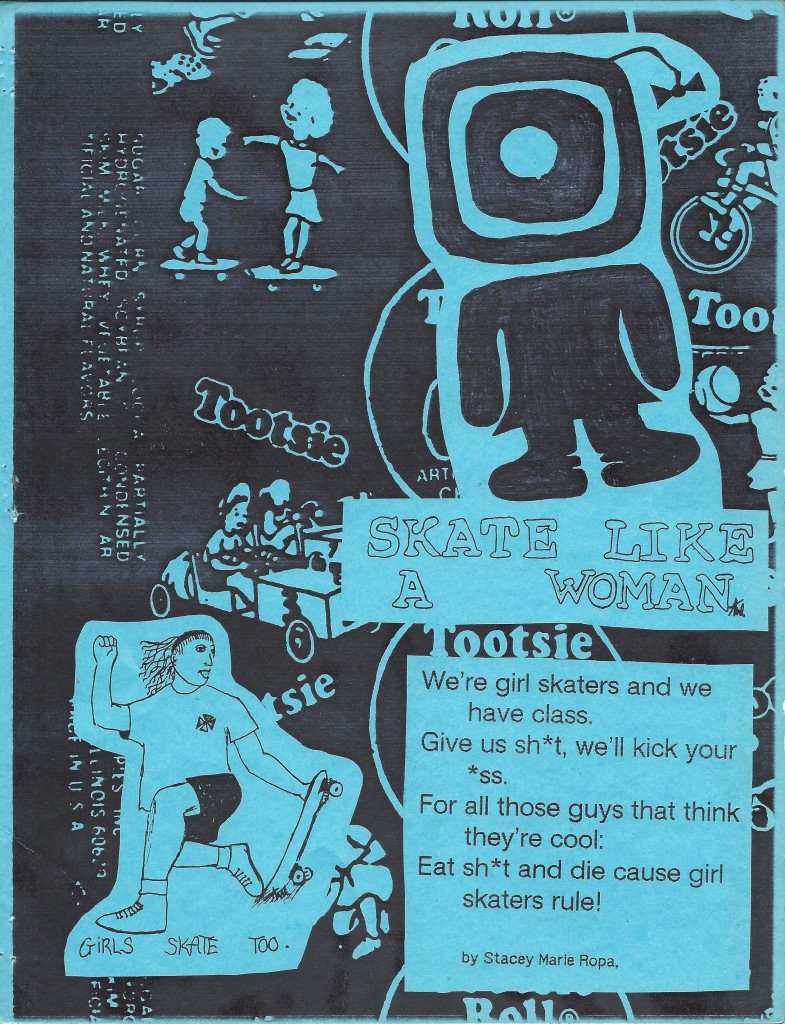
On Instagram, Stace wrote:
“Oh man, my Equal Time mags are some of my most prized possessions!… Those mags and the mailing list (I still have) were the only things that reminded me I wasn’t alone in the world… cause I was so isolated and imagine how excited I was when Lynn came to visit! I’m so glad we’ve stayed in touch for over 35 years and I’ve enjoyed watching Lynn absolutely still kill it on a skateboard! Congrats Lynn and thank you so much for writing me back when you did!” (IG comment September 13, 2022).
The 1990s included some highs and lows for Stace. The good times was when, “I’d rock up somewhere to skate, they’d never seen a girl ride a skateboard before and bombard you with questions. My friend Jinx kept me ahead of the time, I’d learn tricks and go to a city where they hadn’t figured them out yet, and blow guys minds.” But the bad times involved injury.
In 1994, Stace messed up her knee playing soccer in a Men’s league. And it was bad! A torn ACL and PCL with the advice to “go to the gym and just strengthen it” when it should’ve been reconstructed. “I had to learn to walk without limping and the doctor told me I’d never be able to run again, I was 23 years old… Anyway I swear to god, the day I blew out my knee, I saw another girl with a skateboard … I went home and cried… You couldn’t feel more ripped off in life if you tried!!! I’d just gotten good, really good, fearless and coordinated.”
A year later, her friends kept asking if she could skate, so Stace gave it a go. A tentative ollie, then a kickflip, and no debilitating pain! There were some moves she had to avoid where the joint would shift or her knee would pop, but essentially Stace was back. “I met a few skaters; Cheapskates finally had an Open Women’s section at the skateboard Nationals and I put enough tricks together to win the first year. The years that followed we had awesome skaters come through.”

The skateboarding industry was also slowly evolving, recognizing that there were some talented female skaters who were carving out their own path via events like the All Girl Skate Jam and Gallaz Skate Jam over in Melbourne, Australia.
Stace was still involved, skating hard, and got to be a kind of mentor to a young Kiwi named Georgina Matthews.
“Georgina Matthews being the first girl as obsessed with skateboarding as much as me and keen to travel. She was 13 years old when we first met. She won skateboard Nationals and just ripped so hard. I wish I’d met her 15 years prior. (Unlike the Paraparaumu thing, I was stoked to get second to Georgie, and was happy to just be skating). We got on well and we went to the States that year. And the Gallaz skate jam in [Melbourne] Australia the next year. Georgie placed second equal with Sally Clarke and I was given 3rd place. I was so stoked, because I’m like 30 years old and everyone else was under 20 lol. I didn’t care, I just wanted to skate with other women.”
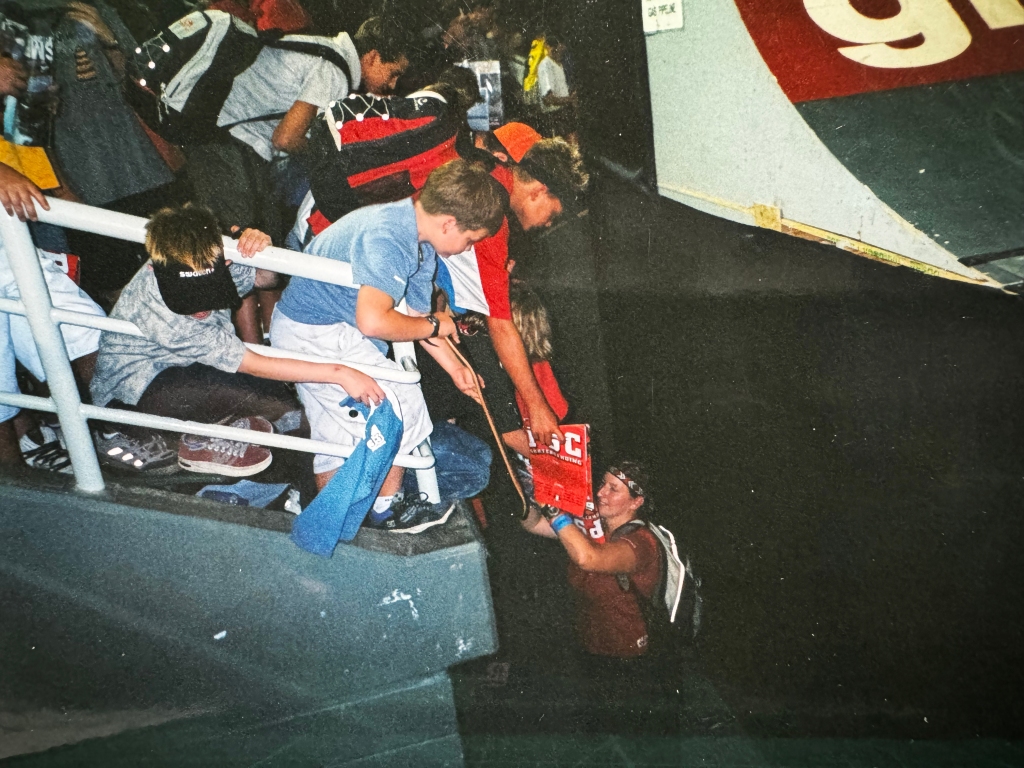
Photo: Stace signing autographs at Globe World Cup 2003
Stacey competed in the Gallaz World Cup in 2002, 2003 and 2005, as listed in the Girls Skate Network, and she was also the correspondent for Push magazine, reporting on the Gallaz Skate Jam in the Spring 2003 issue. In the fall of 2005, she travelled over to Canada, competing in the West 49 Open, where it’s listed she had pulled together some sponsors including Boom Skateboards, Gallaz, and Boom Girl. And when she competed, Stace was always true to herself and her style, which I think is pretty cool. She said,
“I remember them wigging out at all my old school tricks, (it wasn’t just because I liked old school, it was because I am Old School)! Go to any skatepark and kids instantly swam around you and ask you to show them the old stuff. For the first time ever, I felt really proud to be a skateboarder in front of people. I just did old school tricks and frontside noseslide shuvits everywhere I went. If there was a good bank, throw in the Bertlemann slides for good measure lol. I was older, skating with a pretty bung very swollen knee, I was never in it for the prizemoney (I was working as an Art Director in a pretty big Ad Agency funding my travels).”
This was during an era when skaters didn’t have “coaches,” compared to today with the Olympics and high stakes events like SLS. So, Stace with her background in competitive sports, would often suggest tricks to Georgie that looked rad and would suit her style or offer some tips. As a result, they became strategic in planning their runs.
“We had so much fun travelling, when she was 16 and I was 30, we stayed at my sister’s place in LA for 6 weeks before heading to the West 49 Canadian Open. Georgina placed 4th (I personally thought she skated good enough for 2nd, but I’m bias), I placed 12th doing my old school shit and that was the best contest result I ever had outside of Australasia. I mean, Vanessa Torres and LynZ Adams-Hawkins, Lauren Perkins, the who’s who of women’s skateboarding was represented. The course was massive.”


Georgie has repeatedly acknowledged Stacey’s impact. In June 2017, she stated, “One of my biggest inspirations was Stacey Roper from Taranaki, who was a bit older than me. She’d push all the girls to skate together, we’d skate together every weekend in Auckland.”
More recently, Georgina said in her Manual Magazine interview that, “Stacey and I have been great friends. Stacey travelled with me when we competed in the All Girl Skate Jams, Canadian World Cup, Globe World Cups, and all around the States and Australia. She is a big inspiration of mine, and she was one of the first competitive female skaters in New Zealand. Stace would tell me stories of growing up skateboarding in the ‘70s and ‘80s. She’s even taught me a few old school tricks.”
While traveling was a privilege, Stace still paid her dues, even chipping a kneecap on one of her more remote trips, which meant a chunk of bone stayed in her joint for the next 10 years! Overall, “Those years were so awesome.” Stace was skating demos with amazing female skaters and surfers, which she never thought would be part of her experience. And she made sure to give back to her own community, like launching a girls’ night in 2001.
“Back home, we had an indoor skatepark owned and run by Dan Whinery (RIP), and his mum Marie. I would go and skate the double session every Friday night. Marie approached me about a girls’ session, and I wasn’t sure there were enough skaters for our own day. Marie would see the all the girl friends just sitting around the park not wanting to get in the way of the guys.
So we approached Dan and we negotiated every Tuesday from 6pm until 7pm to let girls in only until it was an open session at 7pm until 9:30pm. Me and Emily Lee were there as support and mentors and we were stoked 5 girls rocked up to the first session. After about a year we grew to around 20 girls every Tuesday session. It was amazing. Some as young as 9 right through to mid 30s (oh that might be me lol). We grew our crew…”
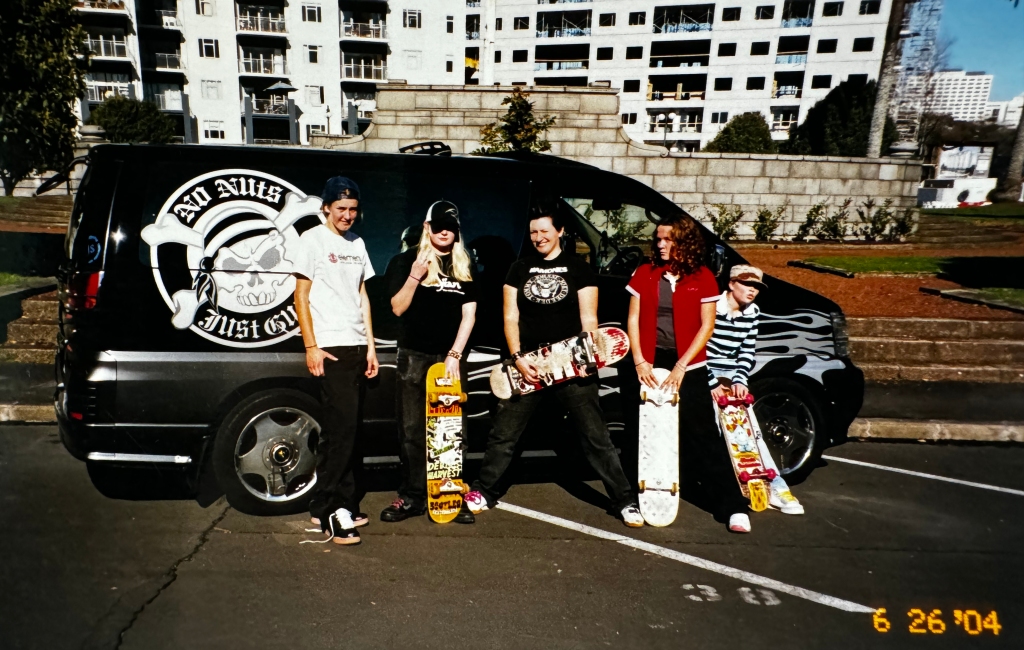
Photo: “No Nuts Just Guts” – Black Betty (the van) and the weekend crew, Sophie Allen, Jessica Price, Stace, Clare Briffett, Tessa Donovan 2004
And when the park shut down, Stace stepped up and bought a van to keep the girls skate crew together racking up over 400,000 kms, all to a sweet 80s skate-rock soundtrack! “We’d meet every Saturday and Sunday at the Train Station in Auckland and I’d drive us to the skateparks. There are so many in Auckland, you could go to a different area each day and skate somewhere different. The 9 year old is in her 30s now and man we had so much fun!”
“I never thought about it being a mentor to others, but with Georgie, I could live vicariously through her to some degree. There are always tricks I couldn’t do any more but she could!!! It was so rad watching her and others improve. I just basically told them what looked cool in photos hahaha, which is rich coming from me who never took any or had many taken or filmed pretty much nothing. I was too busy living to care about collecting footage, I just wasn’t that interested at the time.
I mean obviously now I wish I had… But at the time you don’t ever think you won’t be able to skate the same again. That jumping around would hurt so much. I do regret it, but skateboarding was for me, it was just my thing. It lives inside me, only I know what it felt like doing my tricks, the tiny muscle flexes in all the weird places, the sounds made sliding along a ledge, a good pop, rolling at speed. Laughing with your friends, hoping this life will never end. We didn’t carry around video cameras in our back pocket. It just never mattered to me.”
And yet, Stace did make an effort to film on occasion. She described going to Shanghai, China in 2006 on a trip with six girl skaters (Stace, Sophie Allen, Hilary Pearce, Monica Shaw, Sally Clark, and Georgina Matthews) and two male photographers. “I filmed what I could for a TV show in NZ but they lost our interview tapes and most of the footage. (I’m just destined to never be filmed or photographed lol).” There was also the time that SG Magazine (July 2005) wrote “an article on Aussie and NZ and they photoshopped off my mohawk! (the story of my life hahaha).” Too funny!
Several of these Aussie skaters would form a group known as “The Skullz” (with a very lively website and international forum for girl skaters), which was always entertaining.
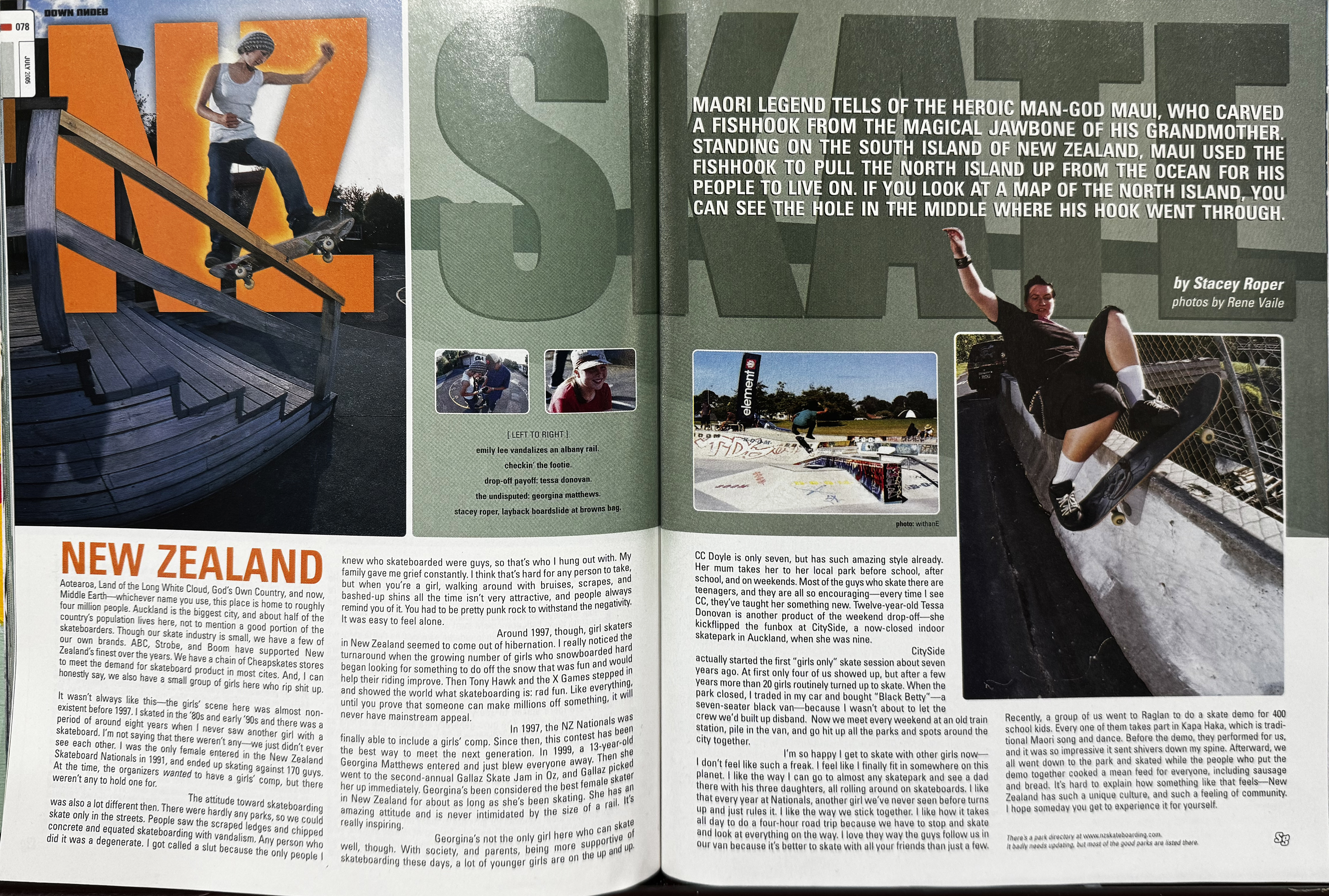

Photo: the cropped mohawk!! ARgh
Stace remembered going to the States and meeting an Aussie skater named Louisa Hawton from Perth (a two-time World Boxing champion!) and just having the most epic times. “Her and Esther Godoy have some funny stories to tell you from the 900° parties they had at the Globe World Cup. Whenever those two were around, mischief ensued…”
Stace recounted another U.S. trip hanging out with her sister, who happens to be a Rugby coach and skater, Violet Kimble (who would eventually move to NZ). They messed around playing rugby in the backyard, and it just made sense to give Violet a rugby ball for her birthday the following year at the Globe World Cup in Australia…
“It had been raining so we couldn’t skate, we got the rugby ball and went into the park across the road from Novatel, Melbourne and played the worst game of rugby NZ vs Australia you could imagine. I know Monica Shaw stubbed out cigarette and joined Violet and Sally Clark and one other for Team Aussie, and Louie joined Me and Georgie in Team NZ with a very young Leo Baker (who chose NZ because they’d heard NZ were good at rugby lol). Wearing bagging jeans and skate shoes on slippery wet grass! I think maybe Vanessa Torres & Amy Caron were watching and Hizza [Hilary Pearce] as well. Amanda France? It was quite mental at the time lol!”
And in good news, Stace reported that, “My mum eventually came around to the fact it wasn’t a phase and finally bought me something skateboard related for xmas, TNT limited edition Vans lol.” It definitely wasn’t a phase because at the 2010 New Zealand Nationals, Stacey took top honours with a first place at age 39, just days before her 40th birthday! She was ahead of Sarah Watkins and Anna Silich, as reported on in the NZ Skateboarder Annual (2011). Unfortunately, no photos were included but somewhere a photo exists of the three winners.
More recently, Stace shared that, “Seeing skateboarding in the Olympics brought a tear to my eye, I don’t think this generation has any idea what it was like in the 80s and 90s. (I mean you wouldn’t dare tell work you rode a skateboard, they might fire you). Until X Games and the Tony Hawk video game, skateboarders were dirt bags. Once money was involved, it changed everything. But I love watching and I watch everything still, it’s my favourite sport. I’ll watch every comp they stream! I still cheer the girls on from my couch.”
Stacey is still keeping incredibly busy though. These days, she is celebrated for her incredible artistic skill including a feature in Rolling Stone Australia (July 6, 2022) showcasing her pin-striping and official Rat Fink artist status. She also had a profile by filmmaker Cal Thorley in his Hot Rod Revue web series. Apparently, Stacey “got the kustom culture bug after attending the annual rock’n’roll and vintage car festival, Beach Hop, in Whangamata, Bay of Plenty” (Welby), which influenced her artistic practice.
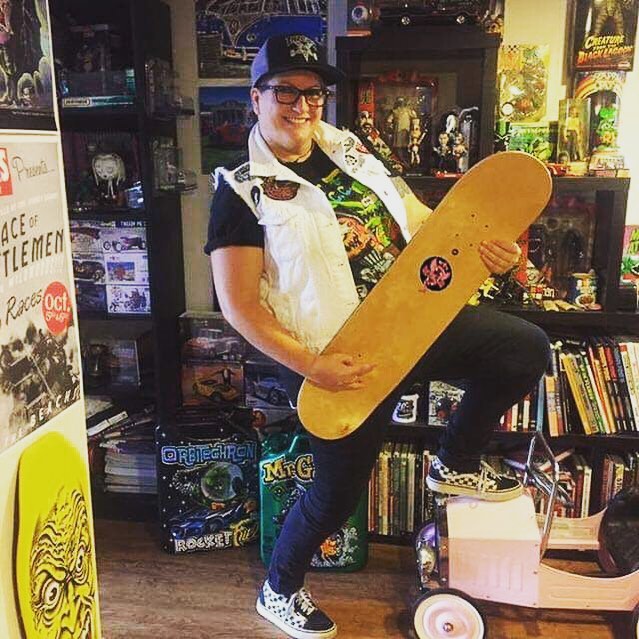
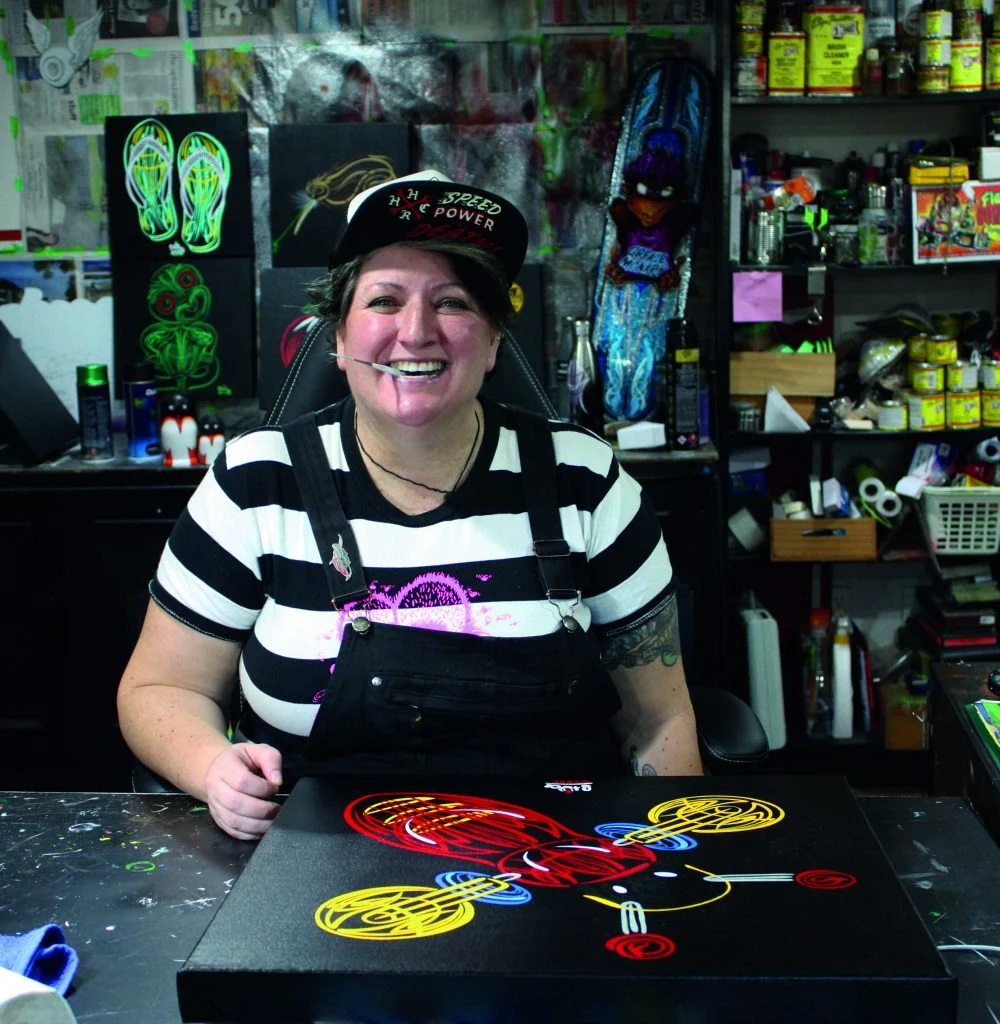
Check out Stacey’s Instagram account for her latest designs and projects where she describes herself as “Low Brow & Weirdo Artist / All things Kustom Kulture / Official Rat Fink Artist / Rat Fink Artist Hall of Fame / Hot Rodder and Old School Skateboarder.”
Stacey’s origin story as a badass skateboarder throughout the 1980s and beyond, and her positive influence on young women in Aotearoa demonstrates a real quality of character and helps thread together a global story of women’s skateboarding history. Thanks Stace! You rule.
Shouts outs: “The Skullz from Aussie, Hilary, Joske, Alicia Saye, Monica Shaw, Sally Clake, Esther Godoy, Louisa Hawton (Bang Bang Lou Lou)”
Final words: “The thing I love about skateboarding is how challenging it is! It’s so hard to learn new tricks, you pay your dues man each time, but what it has done for me, it put everything else in my life into perspective. Everything is easy compared to skateboarding. It means, I skateboarded so whatever I put my mind to, I will persevere until I accomplish it. If I could get decent at skateboarding (before the knee blowout), I could do anything!”
References:
- Welby, Augustus. “‘Hot Rods are Actually F*cking Sick’: The Weirdo Art of Pinstriper and Illustrator Stace the Ace.” Rolling Stone Australia. July 6, 2022.
- Rankine, Jenny. “Being the Daughters of Ally.” Lesbian News Aotearoa. July 2017.
- Read, David. “Georgina Matthews: Folklore.” Manual Magazine. April 2022.

